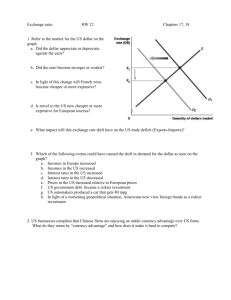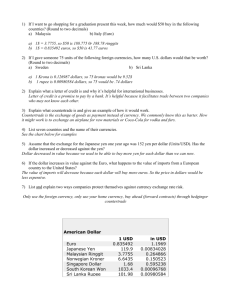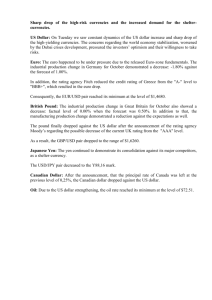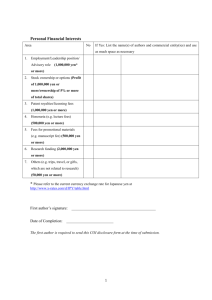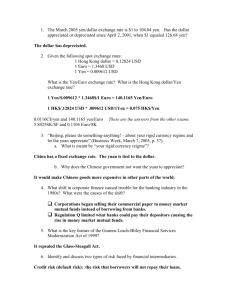EconS 327 Review for Test 2 Test 2 is on Friday, April 24 Test 2 has
advertisement
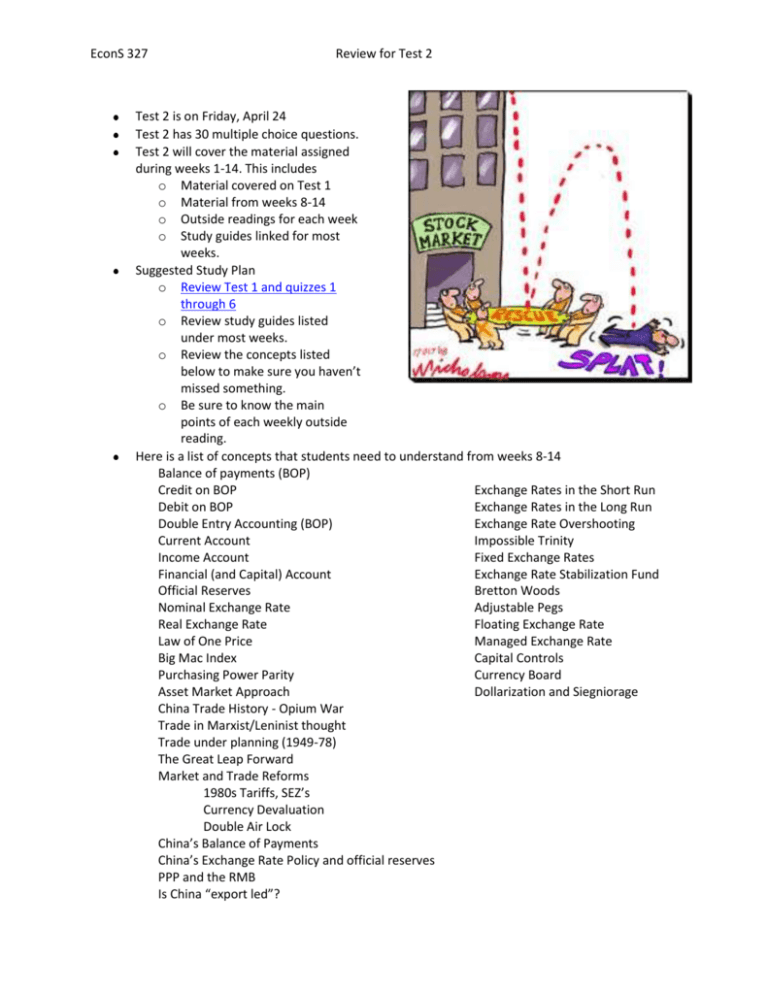
EconS 327
Review for Test 2
Test 2 is on Friday, April 24
Test 2 has 30 multiple choice questions.
Test 2 will cover the material assigned
during weeks 1-14. This includes
o Material covered on Test 1
o Material from weeks 8-14
o Outside readings for each week
o Study guides linked for most
weeks.
Suggested Study Plan
o Review Test 1 and quizzes 1
through 6
o Review study guides listed
under most weeks.
o Review the concepts listed
below to make sure you haven’t
missed something.
o Be sure to know the main
points of each weekly outside
reading.
Here is a list of concepts that students need to understand from weeks 8-14
Balance of payments (BOP)
Credit on BOP
Exchange Rates in the Short Run
Debit on BOP
Exchange Rates in the Long Run
Double Entry Accounting (BOP)
Exchange Rate Overshooting
Current Account
Impossible Trinity
Income Account
Fixed Exchange Rates
Financial (and Capital) Account
Exchange Rate Stabilization Fund
Official Reserves
Bretton Woods
Nominal Exchange Rate
Adjustable Pegs
Real Exchange Rate
Floating Exchange Rate
Law of One Price
Managed Exchange Rate
Big Mac Index
Capital Controls
Purchasing Power Parity
Currency Board
Asset Market Approach
Dollarization and Siegniorage
China Trade History - Opium War
Trade in Marxist/Leninist thought
Trade under planning (1949-78)
The Great Leap Forward
Market and Trade Reforms
1980s Tariffs, SEZ’s
Currency Devaluation
Double Air Lock
China’s Balance of Payments
China’s Exchange Rate Policy and official reserves
PPP and the RMB
Is China “export led”?
EconS 327
Review for Test 2
Please fill out the course evaluations for EconS327/IBUS470. Here are the instructions:
Thanks, Dr. H
Log on to my.wsu.edu with your WSU Network ID and password.
The links to surveys are listed under official Notices in myWSU, one per course section. Open your
notice and click on the link to take you to your evaluation.
Your responses are completely confidential. A file separate from the course evaluation will save your
name so your faculty can see your name if they have chosen to give extra credit for completing the
evaluation. The file with your name is not linked in any way to your confidential survey responses.
Please complete evaluations for each of your courses, your responses are very important to your faculty.
They give valuable feedback on what is working for you in the course or what needs improvement.
If you have any trouble or questions, please enter a support request at this web site:
http://support.ctlt.wsu.edu
Here are a few sample multiple choice questions for practice.
1. In a country’s balance of payments, which of the following transactions are debits (minuses)?
a. Domestic bank balances owned by foreigners are decreased
b. Foreign bank balances owned by domestic residents are decreased
c. Assets owned by domestic residents are sold to nonresidents
d. Securities are sold by domestic residents to nonresidents
2. The net value of flows of goods, services, income, and unilateral transfers is called the:
a. Capital account.
b. Current account.
c. Trade balance.
d. Official reserve balance
3. A country experiencing a current account surplus:
a. Needs to borrow internationally.
b. Is able to lend internationally.
c. Must also have had a surplus in its capital account.
d. Spent more than it earned on its merchandise and service trade, international income
payments and receipts and international transfers.
4. In recent years the US has
a. Had a current account surplus
b. Had a financial (capital) account surplus
c. Been a net lender to the world
d. Experienced a dramatic decrease in its official foreign reserves
EconS 327
Review for Test 2
5. Suppose the exchange rate between the Japanese yen and the U.S. dollar is initially 100 yen per
dollar and then falls to 80 yen per dollar. As a result the “Yen price” of a product that the US
exports for $5 will
a. Increase from 500 Yen to 540 Yen
b. Decrease from 500 Yen to 400 yen
c. Increase from 400 Yen to 500 Yen
d. Decrease from 540 Yen to 500 Yen
6. A decrease in German residents' willingness to invest in dollar-denominated assets will shift the
demand curve for:
a. Euros to the right
b. Euros to the left
c. Dollars to the right
d. Dollars to the left
Figure 17.1: The Market for British Pounds
$/£
S£
2.50
2.00
1.50
D£
5
5.5
6
£’s (millions)
7. Referring to figure 17.1, if the British government wants to peg the exchange rate of the pound at
$2.50 per pound, what action would British monetary authorities have to undertake?
a. Sell 1 million pounds and buy 2.5 million dollars.
b. Buy 1 million pounds and sell 1 million dollars.
c. Buy 1 million pounds and sell 2.5 million dollars.
d. Buy 5.5 million pounds and sell 11 million dollars.
8. Referring to figure 17.1, if the British pound is pegged at $2.50 per pound the pound will be:
a. Overvalued
b. Undervalued
c. Devalued
d. In equilibrium
EconS 327
Review for Test 2
9. In the short run, a drop in short run European interests rates will lead to:
a. An inflow of capital to Europe.
b. An increase in the demand for euro-denominated financial assets.
c. A decrease in the demand for euro-denominated financial assets.
10. ____________________ states that a bundle of tradable products will have the same cost in
different countries if the cost is stated in the same currency.
a. Covered interest rate equilibrium
b. Trade equilibrium
c. The law of comparative advantage
d. Purchasing power parity
11. Suppose the average price of a Big Mac in the United States is $4.00 while in Japan the average
price is 500 yen. If the price of a dollar is 100 yen per dollar, the purchasing power parity model
of exchange rate determination suggests:
a. The yen is overvalued.
b. The yen is undervalued.
c. The price of a Big Mac in Japan will rise.
d. The price of a Big Mac in the US will decrease
12. Suppose that US prices rise 4% over the next year while prices in Mexico rise 6%. According to the
purchasing power parity theory of exchange rates, what should happen to the exchange rate
between the dollar and the peso?
a. The dollar should depreciate.
b. The peso should appreciate.
c. The peso should depreciate.
d. The dollar will be revalued.
13. Exchange rates are determined in the long-run by:
a. Interest rate differentials.
b. Purchasing power parity.
c. Financial asset pricing.
14. Pressures in the foreign exchange rate market are such as to cause the British pound to
depreciate with respect to the U.S. dollar. If Britain is trying to maintain a fixed exchange rate
with respect to the U.S. dollar, which of the following interventions will stem the pressures for
depreciation of the pound?
a. Britain should sell pounds and buy dollars.
b. Britain should do nothing as a fixed rate will not change.
c. Britain should buy pounds and sell dollars.
d. Britain should increase their money supply to create domestic inflation.
EconS 327
Review for Test 2
Figure 20.1: The Foreign Exchange Market
$/ £
S £ (spring - summer)
$2.20
S £ (autumn - winter)
$1.90
$1.60
D£
30
40
50
60
70
£
(billions)
15. Referring to figure 20.1, assuming that the British government is committed to maintaining a
fixed exchange rate at $1.90 per pound. In the spring-summer period, what type of intervention
must British monetary authorities engage in?
a. Sell 20 billion pounds at $1.60.
b. Sell 20 billion pounds at $1.90.
c. Sell 10 billion pounds at $2.20.
d. Buy 20 billion pounds at $1.90.
16. Suppose country A has abundant labor and scarce capital. Product L requires labor intensive
production. Product K requires capital intensive production. A result of free trade, in the long
run
a. Wages will decrease in country A
b. The price of capital will decrease in country A
c. The price of Product L will decrease in country A
d. The price of Product K will increase in country A
17. There are only two countries. Country A imports zimboes from Country B. Country A also
produces some of its own zimboes. If country B imposes a trade embargo on country A then as a
result,
a. The price of zimboes in country A will decrease
b. Producers surplus (for zimbo producers) in country A will decrease
c. Consumer surplus (for zimbo consumers) in country A will increase
d. The producer surplus (for zimbo producers) in country B will decrease
18. If a large country imposes a tariff on imports of good A, the world price of good A will _____
and the domestic price of good A will ____.
a. Rise, rise
b. Fall, rise
c. Stay constant, rise
EconS 327
Review for Test 2
d. Stay constant, fall
19. In country A is a small country that produces, consumes and exports some its production of the
grain, millet. Increases in world grain and petroleum prices cause two things to happen that
affect country A. (1) The world price of millet increases along with other grain prices, and (2)
petroleum price increases cause the world price of nitrogen fertilizer to double. Country A
imports fertilizer to be used in its production of millet. The trade model for a small country
predicts unambiguously (for sure)
a. Country A’s production of millet will decrease
b. Country A’s production of millet will increase
c. Country A’s exports of millet will increase
d. Country A’s consumption of millet decrease
20. China’s Great Leap Forward was an example of
a. The gains from intraindustry trade
b. Potential losses when trade by comparative advantage are not allowed
c. The use of subsidies to promote exports
d. The advantages of specialization according to comparative advantage
21. During the planning stage of the Chinese economy (roughly 1949-1978) China’s approach to
international trade was
a. Consistent with Mercantilist theory
b. To export primary products like oil so they could import capital goods
c. To peg the Chinese currency to the Japanese Yen
d. To export products that were labor intensive in production
22. Using the most recent trade statistics (2007), apparel was the 4th largest category of Chinese
exports to the US. The largest category of Chinese exports to the US was
a. Footwear
b. Toys and dolls
c. Computer equipment
d. Auto parts
23. In 2005, the Chinese switched from a fixed exchange rate to a “managed crawling peg”. During
subsequent period (July, 2005 – April, 2008), the exchange rate (RMB/US$)
a. Remained about the same at 8.27RMB/US$
b. Appreciated from 8.27RMB/US$ to about 7RMB/US$
c. Depreciated from about 8.27RMB/US$ to about 10RMB/US$
d. Depreciated from about 8.27RMB/US$ to about 8.5RMB/US$
24. Currently the exchange rate for the Chinese currency (RMB/US$)
a. Is set so that the RMB is undervalued (against the US$)
b. Leads to an excess demand of US$
c. Is partly responsible for the flow of financial capital into China
d. Is pegged to the Euro
25. According to Naughton, Chinese market reforms started around 1978. In the early part of these
reforms (late 70s and early 80s)
a. Oil was China’s largest import category
b. Oil was China’s largest export category
c. Rice was China’s largest export category
d. Rice was China’s largest import category
EconS 327
Review for Test 2
26. According to Naughton, during the opening of trade in the 1980s China used a “double air lock”
to insulate their domestic markets from surges of imports. These “double air locks” included
a. Regulations that required all trade to first be unloaded in Hong Kong
b. Regulations requiring that all imports must be labeled using Chinese characters
c. Regulations that required all trade to pass through government operated foreign trade
companies
d. Regulations that required foreign importers to post a performance bond that would be
forfeited in the event that the importer also did business in Taiwan
27. During the early part of the Chinese economic reforms (late 1980s to early 90s)
a. The RMB appreciated
b. Chinese exports shifted away from oil and extractive industries to labor intensive light
industries
c. China joined the WTO
d. Chinese exports and imports (as a % of GDP) fell below the levels of the 1970s
28. The central feature of the Bretton Woods system was:
a. Floating exchange rates.
b. Fully fixed exchange rates.
c. Capital controls.
d. Adjustable pegs.
29. During the period 2006 - 2008 the Chinese trade surplus with the US averaged around $250
billion. During that period China’s official foreign reserves increased dramatically. The
connection between these data is
a. The Bank of China issued Chinese currency to purchase foreign exchange
b. The Bank of China devalued the RMB in 2006-2008
c. The Bank of China reduced their holdings of US Treasury bills
d. The exchange rate of the RMB was pegged to the Euro over this period
EconS 327
Review for Test 2
30. The table below shows balances for the US balance of payments in the years 2000 and 2006.
From these data we see that, in the year 2006 “US Imports of goods and services” was -$2.204
trillion. In the context of the US Balance of Payments this means
a. US imports were $2.204 trillion in 2006
b. The US decreased its imports by $2.204 trillion in 2006
c. The US increased its imports by $2.204 trillion in 2006
d. The US trade deficit was $2.204 in 2006
31. The table below shows balances for the US balance of payments in the years 2000 and 2006.
From these data we see that, in the year 2006 “Foreign-owned assets in the United States” was
+$1.859 trillion. In the context of the US Balance of payments this means
a. Foreigners increased their asset holdings in the US by +$1.859 in 2006
b. Foreigners decreased their asset holdings in the US by +$1.859 in 2006
c. Foreign owned assets in the US totaled +$1.859 in 2006
d. The US trade deficit was +$1.859 in 2006
US Balance of Payments (Credits +; debits -)
2000
2006
Exports of goods and services and income receipts
1421515 2096165
Exports of goods and services
1070597 1445703
Income receipts
350918
650462
Imports of goods and services and income payments
-1780296 -2818047
Imports of goods and services
-1450432 -2204225
Income payments
-329864
-613823
Unilateral current transfers, net
-58645
-89595
U.S.-owned assets abroad (increase/financial outflow (-))
-560523 -1055176
Foreign-owned assets in the United States
1046896 1859597
Financial derivatives, net
n.a.
28762
Statistical discrepancy
-67937
-17794
Memoranda:
Balance on goods and services
-379835
-758522
Balance on income
21054
36640
Unilateral current transfers, net
-58645
-89595
Balance on current account
-417426
-811477
32. According to the Financial Times rating of MBA programs, one difficulty in comparing starting
salaries for different MBA programs is that
a. Many MBAs are unemployed
b. Many MBAs earn unreported perks
c. Converting salaries using exchange rates doesn’t account for price differences in different
countries.
d. Different countries have different tax rates.
EconS 327
Review for Test 2
33. Suppose, these are the market prices
Today’s price of the £: $2.00 per pound
90 day interest rate in US 4%
90 day interest rate in UK 4%
The US Federal Reserve then announced (unexpectedly) that it would raise US interest rates to
6%. As a result the ___________ for the ___________would decrease and the price of the
pound would ______ $2.00 per pound.
a. Demand; Dollar; fall below
b. Demand; Pound; fall below
c. Demand; Dollar; rise above
d. Supply; Pound, rise above
34. In Country A, the government has a government budget deficit (tax revenues < government
expenditures). Country A has a surplus on its current account. {Note: Country A’s situation is
similar to Japan during the last decade.} Country A will have a _________ in its capital account.
a. Deficit
b. Depreciation
c. Lag
d. Balance
35. An increase in U.S. capital inflows will be associated with
a. An increase in the US current account surplus
b. An increase in US interest rates
c. A smaller US trade deficit
d. Higher foreign interest rates
EconS 327
Review for Test 2
36. Which of the following terms describes an exchange rate regime in which the government
intervenes in the foreign exchange market in order to influence the market determined exchange
rate?
a. Fully convertible
b. Currency control
c. Managed float
d. Clean float
37. Hong Kong has a currency board. Under this exchange rate regime
a. The Hong Kong $ floats
b. The Hong Kong $ follows an adjustable peg to market basket of currencies
c. The Hong Kong $ is managed so that Hong Kong’s current account must balance
d. The Hong Kong $ is fixed against the US $
38. Ecuador has “dollarized”. This means that Ecuador
a. Has no ability to set domestic monetary policy and interest rates
b. Every Ecuadorian dollar is backed by 7.75 US dollars
c. Ecuador gains from seigniorage
d. Gets a “free, interest rate loan” from the US
39. According to the “Impossible Trinity”, it is impossible to do 3 Things at the same time. These 3
Things are
a. Free capital flows, free immigration flows, and free trade flows
b. Government budget deficit, current account deficit, and negative personal savings
c. Free capital flows, independent monetary policy, and fixed exchange rates
d. Democracy, economic growth, and low corruption
40. Exchange rate stabilization requires that a country’s central bank
a. Use an expansionary monetary policy to offset a depreciation of its currency
b. Raise interest rates to offset a depreciation of its currency
c. Raise taxes to offset a depreciation of its currency
d. Raise import tariffs to offset a depreciation of its currency
Answers on the next page
EconS 327
1
2
3
4
5
6
7
8
9
10
11
12
13
14
15
16
17
18
19
20
21
22
23
24
25
26
27
28
29
30
31
32
33
34
35
36
37
38
39
40
Review for Test 2
A
B
B
B
B
D
C
A
C
D
A
C
B
C
B
B
D
B
D
B
B
C
B
A
B
C
B
D
A
A
A
C
B
A
B
C
D
A
C
B

